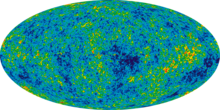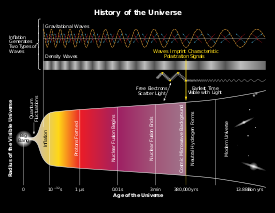Big Bang
| Part of a series on |
| Physical cosmology |
|---|
 |
Since Georges Lemaître first noted, in 1927, that an expanding Universe might be traced back in time to an originating single point, scientists have built on his idea of cosmic expansion. While the scientific community was once divided between supporters of two different expanding Universe theories, the Big Bang and the Steady State theory, accumulated empirical evidenceprovides strong support for the former.[8] In 1929, from analysis of galacticredshifts, Edwin Hubble concluded that galaxies are drifting apart, important observational evidence consistent with the hypothesis of an expanding Universe. In 1965, the cosmic microwave background radiation was discovered, which was crucial evidence in favor of the Big Bang model, since that theory predicted the existence of background radiation throughout the Universe before it was discovered. More recently, measurements of the redshifts of supernovae indicate that the expansion of the Universe is accelerating, an observation attributed to dark energy's existence.[9] The known physical laws of nature can be used to calculate the characteristics of the Universe in detail back in time to an initial state of extreme density and temperature.
Overview
| . |
Hubble observed that the distances to faraway galaxies were strongly correlated with their redshifts. This was interpreted to mean that all distant galaxies and clusters are receding away from our vantage point with an apparent velocity proportional to their distance: that is, the farther they are, the faster they move away from us, regardless of direction.[17] Assuming theCopernican principle (that the Earth is not the center of the Universe), the only remaining interpretation is that all observable regions of the Universe are receding from all others. Since we know that the distance between galaxies increases today, it must mean that in the past galaxies were closer together. The continuous expansion of the Universe implies that the Universe was denser and hotter in the past.
Large particle accelerators can replicate the conditions that prevailed after the early moments of the Universe, resulting in confirmation and refinement of the details of the Big Bang model. However, these accelerators can only probe so far into high energy regimes. Consequently, the state of the Universe in the earliest instants of the Big Bang expansion is still poorly understood and an area of open investigation and indeed, speculation.
The first subatomic particles included protons, neutrons, and electrons. Though simple atomic nuclei formed within the first three minutes after the Big Bang, thousands of years passed before the first electrically neutral atoms formed. The majority of atoms produced by the Big Bang were hydrogen, along with heliumand traces of lithium. Giant clouds of these primordial elements later coalesced through gravity to form stars and galaxies, and the heavier elements were synthesized either within stars or during supernovae.
The Big Bang theory offers a comprehensive explanation for a broad range of observed phenomena, including the abundance of light elements, the cosmic microwave background, large scale structure, and Hubble's Law.[6] The framework for the Big Bang model relies on Albert Einstein's theory of general relativity and on simplifying assumptions such ashomogeneity and isotropy of space. The governing equations were formulated by Alexander Friedmann, and similar solutions were worked on by Willem de Sitter. Since then, astrophysicists have incorporated observational and theoretical additions into the Big Bang model, and its parametrization as the Lambda-CDM model serves as the framework for current investigations of theoretical cosmology. The Lambda-CDM model is the standard model of Big Bang cosmology, the simplest model that provides a reasonably good account of various observations about the Universe.



1 टिप्पणी:
I liked the art written by you very much, you have written the post with great research and hope from you that you will also write well artistic and we will support you. Free me paise kaise kamaye thank u
एक टिप्पणी भेजें